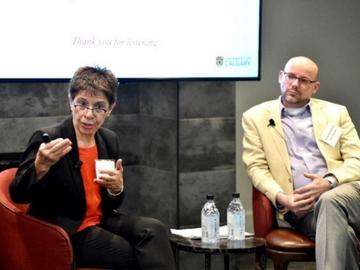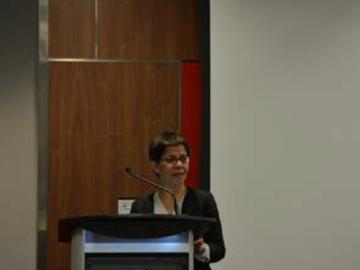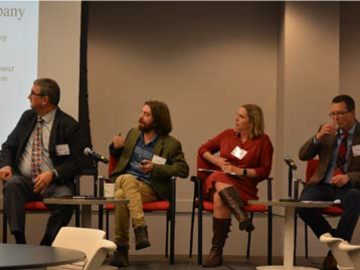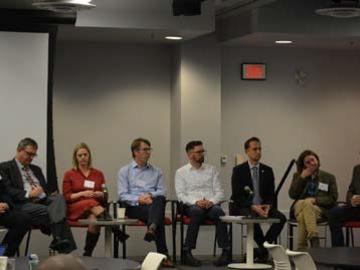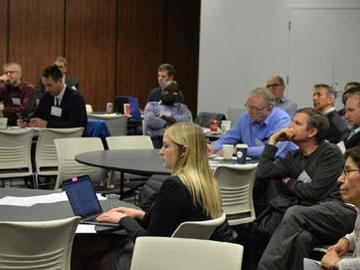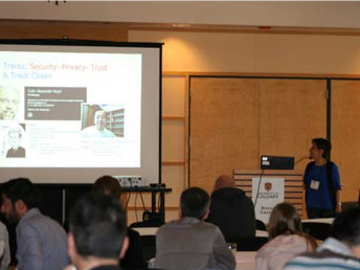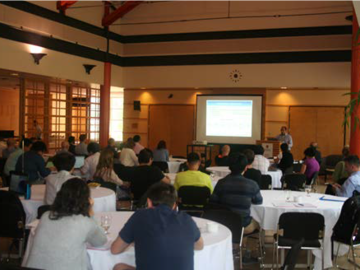News and Events
Latest news
UCalgary research raises questions about internet security
Computer scientist Joel Reardon in Faculty of Science, and U.S. colleague, uncover privacy concerns about ‘root certificate authority’
Partners team up to fight cybercrime
UCalgary brings expertise in network and software security to partnership with police and industry
Computer science alum aims to preserve people’s privacy in internet-connected 'smart' environments
Faculty of Science grad Emmanuel Onu is developing a 'privacy assistant' tool that works with mobile phones
Congratulations to Dr. Joel Reardon for recent award
Joel Reardon has received the Emilio Aced Research and Personal Data Protection Award.
UCalgary computer science and business professors advise Bank of Canada on central bank digital currency design
Interdisciplinary team selected to propose a framework that supports centralized digital cash
Upcoming events
Past Information Security Talks
Speaker: Professor Alfred Lehar
Time/Date: Wednesday April 2, 11 am
Abstract: The talk will discuss incentives to re-order blocks for financial gain and potential mechanisms to prevent that. We will examine in detail the economics of block building and touch on other mechanisms on how block builders can exert market power.
Short Bio: Alfred is professor in the finance area. He has been teaching at the Haskayne School of Business since 2005. He received an undergraduate degree and a PhD from the University of Vienna. Prior to Joining Haskayne, Alfred held positions at the University of Vienna and the University of British Columbia. Alfred teaches a introductory finance for the MBAs and a class on Corporate Finance for PhD students. Alfred's areas of research interest include fintech, bank regulation, financial stability, and corporate finance. Alfred is currently researching mining fees and price differentials in Bitcoin markets, decentralized exchanges, and under what conditions renegotiations can facilitate a private sector workout of a financial crisis. He also works on how information produced by financial markets can be optimally used in bank regulation. In his previous research Alfred developed several methods on how to measure the probability of a financial crisis, analyzed conflicts of interest for financial Analysts, and looked at the empirical fit of alternative option pricing models. Alfred’s work has been published in the Review of Financial Studies, Management Science, the Journal of Financial Intermediation, the Journal of Banking and Finance, and the Review of Finance.
Speaker: Professor Alfred Lehar
Time/Date: Monday March 31, 11 am
Abstract: The talk will describe some technical aspects as well as applications of fungible and non-fungible tokens. We will also discuss the most important on-chain trading mechanism for tokens – the automated market maker.
Short Bio: Alfred is professor in the finance area. He has been teaching at the Haskayne School of Business since 2005. He received an undergraduate degree and a PhD from the University of Vienna. Prior to Joining Haskayne, Alfred held positions at the University of Vienna and the University of British Columbia. Alfred teaches a introductory finance for the MBAs and a class on Corporate Finance for PhD students. Alfred's areas of research interest include fintech, bank regulation, financial stability, and corporate finance. Alfred is currently researching mining fees and price differentials in Bitcoin markets, decentralized exchanges, and under what conditions renegotiations can facilitate a private sector workout of a financial crisis. He also works on how information produced by financial markets can be optimally used in bank regulation. In his previous research Alfred developed several methods on how to measure the probability of a financial crisis, analyzed conflicts of interest for financial Analysts, and looked at the empirical fit of alternative option pricing models. Alfred’s work has been published in the Review of Financial Studies, Management Science, the Journal of Financial Intermediation, the Journal of Banking and Finance, and the Review of Finance.
Speaker: Dr. Majid Khabbazian
Time/Date: March 26, 11am via Zoom
Abstract: Blockchain is a distributed state machine technology that has the potential to revolutionize markets and services, as it enables mutually mistrusting entities to cooperate in the absence of a trusted third party. Blockchain applications, however, are not quite ready for mainstream use due to scalability issues. For instance, Bitcoin can currently handle up to 7 transactions per second, while mainstream payment solutions such as Visa can handle tens of thousands of transactions per second. The battle for a scalable solution is, therefore, the blockchain’s moon race. A promising and powerful approach to win this battle is to view the blockchain as a judge. In this approach, users conduct transactions mainly among themselves and interact with the blockchain only in special cases, for example, to resolve a dispute. In this talk, I will explain the Lightning Network system, a Bitcoin scalability solution based on the above approach, and cover some of our work in improving this system.
Short Bio: Dr. Majid Khabbazian is an associate professor in the Department of Electrical and Computer Engineering, University of Alberta, Canada. He holds a Ph.D. in Electrical and Computer Engineering, from the University of British Columbia, Canada. He completed a postdoctoral fellowship at the Computer Science and Artificial Intelligence Lab, MIT. His research interest is in improving fundamental operations and applications in distributed systems. He serves as an associate editor for the IEEE Transactions on Network and Service Managements.
Speaker: Mahmudun Nabi
Time/Date: March 19 & 21, 2025 11:00 am via Zoom
Abstract: Smart contracts are self-executing programs on blockchains like Ethereum, enabling trustless and transparent agreements. Solidity is the primary language for writing Ethereum smart contracts. In this class, we will explore the basics of Solidity and compare its functionality with Bitcoin Scripts. We will also write a simple "Hello World" contract using Solidity and deploy it using Remix IDE. Key takeaways include understanding smart contract structure, differences between smart contracts and Bitcoin Scripts, Solidity syntax, and hands-on development.
Short Bio: Mahmudun Nabi is a Ph.D. candidate in the Department of Computer Science at the University of Calgary, Canada, under the supervision of Dr. Reihaneh Safavi-Naini. His research focuses on smart contract-based secure system design, with an emphasis on developing secure and efficient solutions for decentralized systems.
Speaker: Greg Hagen, Faculty of Law, University of Calgary
Time/Date: March 3, 2025 11:00 am via Zoom
Abstract: This talk will provide a brief overview of the Canadian legal context for contracting with crypto assets. It will briefly discuss crypto contracts, contract law, and electronic transactions legislation. It will also briefly survey some of the existing regulation of crypto assets, including currency law, securities regulation, money services business regulation, and anti-money laundering and terrorist financing regulation in relation to cryptocurrencies. Finally, the talk will raise the problem of how to make private cryptocurrency payments while satisfying the identity verification requirements of anti-money laundering and terrorist financing regulation. The possible use of anonymous credentials to satisfy the EU EidAS 2.0 digital identity regulation and implications for Canada will be discussed.
Short Bio: Gregory Hagen is an Associate Professor in the Faculty of Law at the University of Calgary. His main research interest is in the intersection of law and technology, currently in the areas of the Web3, AI and cybersecurity. He is involved in projects concerning election cybersecurity and the tokenization of carbon credits.
Speaker: Professor Victoria Lemieux
Time/Date: Feb 14, 2025 via Zoom
Abstract: This talk will focus on Decentralized Identity, which is a model for managing digital identities that gives individuals control over their personal information without relying on a central authority. It can be built on blockchain or other distributed ledger technologies to ensure security, privacy, and interoperability. The talk will cover key features of decentralized identity such as how Individuals can create and manage their own digital identities without dependence on third-party providers; Verifiable Credentials that can be used to cryptographically secure credentials from trusted issuers; Decentralized Identifiers (DIDs) that serve as unique identifiers and independently verified; how users can use decentralized identity to only share necessary identity attributes, reducing data exposure and risks of surveillance or breaches that works across multiple platforms and services without requiring centralized authentication providers. The talk will present a number of use cases from self-sovereign identity; to authentication and access control, education, healthcare and sustainable energy.
Short Bio: Victoria L. Lemieux is Professor of Archival Science at the University of British Columbia School of Information and Founder/Co-Lead of Blockchain@UBC, the University’s multidisciplinary research and education cluster on blockchain technology. Victoria’s research interests include risk to the availability of trustworthy records - in particular at the intersection of blockchain record keeping systems, artificial intelligence, privacy, and security - and how these risks impact upon transparency, financial stability, public accountability and human rights. Victoria has won a number of awards for her research and contributions to the fields of archives, records management, blockchain technology, and cybersecurity.
Speaker: Dr. Jeremy Clark, Concordia University
Date/Time: February 10, 2025 11:00 via Zoom
Abstract: Ethereum is a high integrity system for performing computations however it is slow and expensive to use. As a result, many ideas about scaling Ethereum have been proposed: side-chains, layer two's (L2s), sharding, zk-rollups, and optimistic rollups. At present, the most popular are optimistic rollups like Arbitrum or Optimism. In such systems, Ethereum is referred to as L1 (Layer 1) and the rollup provides an environment called L2, which reduces fees and latency but cannot instantly and trustlessly interact with L1. We will discuss how L2s work, resolve disputes, bridge assets between layers, and pass messages.
Short Bio: Jeremy Clark is an Associate Professor at the Concordia Institute for Information Systems Engineering. At Concordia, he holds the NSERC/Raymond Chabot Grant Thornton/Catallaxy Industrial Research Chair in Blockchain Technologies. His research is on applied cryptography, blockchain and financial technology, security, and privacy.
Speaker: KJ (Kyoung Jin) Choi, Haskayne School of Business, University of Calgary
Time/Date: Feb 3, 2025 11:00 am via Zoom
Abstract: This lecture provides a brief overview of monetary history, including the free banking era, the development of the modern banking system, and the evolving role of central banks within it. By exploring this historical context, we aim to understand the new challenges and transformative impact of blockchain technology on the current financial and banking industry.
Short Bio: KJ (Kyoung Jin) Choi is the Future Fund Fellow in Fintech & Digital Economy at the Haskayne School of Business, where he serves as Area Chair and Associate Professor of Finance. KJ holds a PhD in Economics from Washington University in St. Louis, a PhD in Mathematics from the Korea Advanced Institute of Science and Technology (KAIST), and a BS in Mathematics from Pohang University of Science and Technology (POSTECH).
KJ is especially interested in the impact of emerging technologies on financial markets and institutions. His current research focuses on Fintech, Central Bank Digital Currency (CBDC), and Platform Economics, with a particular interest in how groundbreaking technologies shape consumption, investment, and financial market dynamics. He contributed to the Bank of Canada's Model X project (Canada’s CBDC initiative) in collaboration with the computer scientists, including Rei Safavi-Naini, from the University of Calgary.
Speaker: Dr. Renate Scheidler, University of Calgary
Date: Feb 27, 2025 3:00 pm
Abstract: Elliptic curve cryptography was invented independently by Neal Koblitz and Victor Miller in 1985. Elliptic curve based Diffie-Hellman key exchange and digital signatures have been used successfully in many applications, including Bluray players, web browsing, block chain technology and more. Just like RSA and the original Diffie-Hellman and Elgamal digital signature protocols, Shor’s quantum algorithm breaks all conventional elliptic curve based cryptographic schemes in use today. However, in the last 20 years, elliptic curves used in an entirely different manner have emerged as a suitable setting for quantum-resistant public key cryptography. This talk will give an overview of how elliptic curves are used in both conventional and post-quantum cryptography. No prior knowledge beyond very basic crypto (hash functions, cryptographic key agreement, digital signatures) is required.
Speaker bio: Dr. Renate Scheidler is a professor at the University of Calgary, holding a dual appointment in the Department of Mathematics & Statistics and the Department of Computer Science. Her research interests include algorithmic number theory and mathematical cryptology. She earned her MSc in mathematics from the University of Cologne in 1987 and her PhD in Computer Science from the University of Manitoba in 1993. Prior to joining U of C in 2001, she held a permanent faculty position in the Department of Mathematical Sciences at the University of Delaware. In 2006, Scheidler co-founded Women in Numbers, the first in a series of over 25 research networks supporting women scholars in a variety of areas in mathematics. Scheidler is a Fellow of the Association for Women in Mathematics and the recipient of the Canadian Math Society’s 2024 Krieger-Nelson Prize.
Information Security Seminar Series
Speaker: Dr. Ryan Henry, Department of Computer Science, University of Calgary
Date & Time: November 19, 2021 | 12:00 pm Via Zoom
Abstract: This talk outlines some recent results demonstrating how to harness the power of so-called distributed point functions (DPFs) to implement efficient secure multiparty computations (MPC). Secure MPC is a cryptographic primitive that allows a set of mutually distrustful parties to evaluate joint functions on their private inputs without revealing those inputs to one another (nor to any third party). Our new DPF-based technique provides a surprisingly efficient way to implement useful functionalities that were prohibitively costly to realize using prior approaches.
Short biography: Ryan Henry is an assistant professor in the Computer Science Department at the University of Calgary. His research explores the systems' challenges of applied cryptography, with an emphasis on using cryptography to build secure systems that preserve the privacy of their users. In addition to designing and analyzing privacy-enhancing systems, Professor Henry is interested in practical matters like implementing and working toward the deployment of such systems, as well as more theoretical matters like devising number-theoretic attacks against non-standard cryptographic assumptions and developing new models and theories to understand just how efficient "heavy-weight" cryptographic primitives can be.
Speaker: Dr. Joel Reardon, Department of Computer Science, University of Calgary
Date & Time: October 29, 2021 | 12:00 pm Via Zoom
Abstract: As part of a DHS grant to look into contact tracing apps, we made a discovery that critical information about contact tracing data was being put to the system log, where it could potentially be accessed by a number of preinstalled apps from the phone manufacturer and the wireless carrier. In this talk, we look at this data and explore the ways that it can be used, including combined with other types of data collection, to expose users to a number of privacy risks.
Short bio: Joel Reardon is an assistant professor at the University of Calgary and a co-founder of the company AppCensus, Inc. He has also received the Caspar Bowden award for outstanding research in privacy enhancing technologies.
Speaker: Dr. Majid Khabbazian, Department of Electrical and Computer Engineering, University of Alberta
Date & Time: April 30, 2021 | 12:00 pm Via Zoom
Abstract: Blockchain is a distributed ledger technology, which has the potential to revolutionize markets and services as it enables mutually mistrusting entities cooperate in the absence of a trusted third party. Blockchain applications are, however, not yet ready for mainstream use due to scalability issues. For instance, Bitcoin, the first application of blockchain, can currently handle up to 7 transactions per second, while mainstream payment solutions such as Visa can handle tens of thousands of transactions per second. The battle for a scalable solution is therefore, the blockchain’s moon race. A promising and powerful approach to win this battle is to view the blockchain as a judge. In this approach, users conduct transactions mainly among themselves, and only interact with the blockchain in special cases, for example, to resolve a dispute. In this talk, I will explain the lightning network, a Bitcoin scalability solution based on the above approach, and cover some of our recent work in improving it.
Short biography: Dr. Majid Khabbazian is an associate professor in the Department of Electrical and Computer Engineering, University of Alberta, Canada. He holds a Ph.D. in Electrical and Computer Engineering, from the University of British Columbia, Canada. He completed a postdoctoral fellowship at the Computer Science and Artificial Intelligence Lab, MIT. His research interest is in improving fundamental operations and applications in distributed systems such as distributed data storage and distributed ledger.
Speaker: Dr. Sebastian Lindner, Blockchain Technologies Researcher, IOVLabs
Date & Time: March 19, 2021 | 12:00 pm Via Zoom
Abstract: In this talk we discuss the use of elliptic curves for asymmetric cryptography in blockchain applications. We motivate the benefits of elliptic curve cryptography (ECC) over comparable schemes and describe some fundamental operations used in ECC. We then describe current research being worked on in the area involving generalizations of elliptic curves called genus 2 and 3 curves that seem promising for asymmetric cryptography and certain new cryptographic primitives (Verifiable Delay Functions) used in blockchains.
Short biography: Sebastian Lindner is a blockchain technologies researcher at IOVLabs, a DeFi company whose goal is to provide financial inclusion to the developing world.Sebastian received dual Bachelor’s degrees in Computer Science and Pure Mathematics, and both Masters and PhD in Computational Number Theory at the University of Calgary. His research interests include privacy, security and cryptographic aspects of blockchain. He also likes working on efficient consensus alternatives and improving blockchain light client technologies.
Speaker: Dr. Joel Reardon, Department of Computer Science, University of Calgary
Date & Time: January 15, 2021 | 12:00 pm Via Zoom
Abstract: Proximity tracing apps have been proposed as an aide in dealing with the COVID-19 crisis. Some of those apps leverage attenuation of Bluetooth beacons from mobile devices to build a record of proximate encounters between a pair of device owners. The underlying protocols are known to suffer from false positive and re-identification attacks. We present evidence that the attacker's difficulty in mounting such attacks has been overestimated. Indeed, an attacker leveraging a moderately successful app or SDK with Bluetooth and location access can eavesdrop and interfere with these proximity tracing systems at no hardware cost and perform these attacks against users who do not have this app or SDK installed. We describe concrete examples of actors who would be in a good position to execute such attacks. We further present a novel attack, which we call a biosurveillance attack, which allows the attacker to monitor the exposure risk of a smartphone user who installs their app or SDK but who does not use any contact tracing system and may falsely believe they have opted out of the system.
Through traffic auditing with an instrumented testbed, we characterize precisely the behaviour of one such SDK that we found in a handful of apps---but installed on more than one hundred million mobile devices. Its behaviour is functionally indistinguishable from a re-identification or biosurveillance attack and capable of executing a false positive attack with minimal effort. We also discuss how easily an attacker could acquire a position conducive to such attacks, by leveraging the lax logic for granting permissions to apps in the Android framework: any app with some geolocation permission could acquire the necessary Bluetooth permission through an upgrade, without any additional user prompt. Finally we discuss motives for conducting such attacks.
Short biography: Joel Reardon is an Assistant Professor of Computer Science and Parex Innovations Fellow at the University of Calgary. He is also a co-founder of Appcensus, Inc., which provides privacy analytics as a service in the mobile world. He studies systems security at all software layers, and has particular interest in mobile security and privacy, tools for privacy compliance, and secure storage.
Speaker: Dr. Ryan Henry, Department of Computer Science, University of Calgary
Date & Time: November 20, 2020 | 12:00 pm Via Zoom
Abstract: This talk will present a handful of ideas in “applied kid cryptography”, a subfield of cryptography that considers ideas and protocols that are accessible to everyone – even young children. The talk will focus on kid-friendly zero-knowledge proofs of knowledge, key exchange protocols, (local) differentially private polling, and secure multiparty computation.
Short biography: Ryan Henry is an assistant professor in the Computer Science Department at the University of Calgary. His research explores the systems' challenges of applied cryptography, with an emphasis on using cryptography to build secure systems that preserve the privacy of their users. In addition to designing and analyzing privacy-enhancing systems, Professor Henry is interested in practical matters like implementing and working toward the deployment of such systems, as well as more theoretical matters like devising number-theoretic attacks against non-standard cryptographic assumptions and developing new models and theories to understand just how efficient "heavy-weight" cryptographic primitives can be.
Speaker: Dr. Alfred Lehar, Haskayne School of Business, University of Calgary
Date & Time: October 16, 2020 | 12:00 pm Via Zoom
Abstract: Bitcoin users can offer fees to miners who record their transactions in the Blockchain. We document high variation of Bitcoin fees, not only over time, but also within blocks. Further, the blockchain rarely runs at capacity, even though fees tend to be higher when blocks are fuller, so miners appear to be leaving ``money on the table.'' We present a simple model of price discrimination to explain our results. We note that mining pools facilitate collusive equilibria, and estimate that they have extracted least 200 million USD a year in excess fees by making processing capacity scarce.
Short biography: Alfred Lehar is an associate professor in the finance area. He has been teaching at the Haskayne School of Business since 2005. He received an undergraduate degree and a PhD from the University of Vienna. Prior to joining Haskayne, Alfred held positions at the University of Vienna and the University of British Columbia. Alfred’s research focuses around fintech and decentralized finance. He also researches under what conditions renegotiations can facilitate a private sector workout of a financial crisis and works on how information produced by financial markets can be optimally used in bank regulation. In his previous research Alfred developed several methods on how to measure the probability of a financial crisis, analyzed conflicts of interest for financial analysts, and looked at the empirical fit of alternative option pricing models. Alfred’s work has been published in Review of Financial Studies, Management Science, the Journal of Financial Intermediation, the Journal of Banking and Finance, and the Review of Finance.
Information Security Talks
Seminars are held biweekly on Fridays, 12:00PM - 1:00 PM via Zoom, unless otherwise specified.
Title: Sabre: Sender-Anonymous Messaging with Fast Audits
Speaker: Kyle Storrier
Fri May 6, 2022, 12:00pm to 1:00pm; Virtually Via Zoom. Click here to view the presentation slides
Title: Fides: A System for Verifiable Computation Using Smart Contracts
Speaker: Mahmudun Nabi
Fri April 1, 2022, 12:00pm to 1:00pm; Virtually Via Zoom. Click here to view the presentation slides
Title: Bloom Swizzlers for Expressive PIR Queries
Speaker: Anisha Pandya
Fri March 18, 2022, 12:00pm to 1:00pm; Virtually Via Zoom.
Title: Undeniably Plausible Plausibly Deniable Storage
Speaker: Swaminathan Ramesh
Fri March 4, 2022, 12:00pm to 1:00pm; Virtually Via Zoom. Click here to view the presentation slides
Title: Privacy in smart-contract based Fair Exchange
Speaker: Preston Haffey
Fri February 11, 2022, 12:00pm to 1:00pm; Virtually Via Zoom. Click here to view the presentation slides
Title: Information-theoretic Multiterminal Secret Key Agreement
Speaker: Alireza Poostindouz
Fri December 17, 2021, 12:00pm to 1:00pm; Virtually Via Zoom. Click here to view the presentation slides
Title: Bandwidth-aware Multipath Secure Communication
Speaker: Dr. Leila Rashidi
Fri December 3, 2021, 12:00pm to 1:00pm; Virtually Via Zoom. Click here to view the presentation slides
Title: Zero-knowledge Proof: An Introduction
Speaker: Mamunur Akand
Fri October 8, 2021, 12:00pm to 1:00pm; Virtually Via Zoom. Click here to view the presentation slides
Title: An Introduction to Universally Composable (UC) Security Framework of Canetti
Speaker: Sepideh Avizheh
Fri May 21, 2021, 12:00pm to 1:00pm; Virtually Via Zoom. Click here to view the presentation slides
Title: Leakage resilient cheating detectable secret sharing
Speaker: Dr. Sabyasachi Dutta
Fri April 9, 2021, 12:00pm to 1:00pm; Virtually Via Zoom. Click here to view the presentation slides
Title: RANDY: Authentication and Encryption using One-Time Pad
Speaker: Dr. Shoukat Ali
Fri February 26, 2021, 12:00pm to 1:00pm; Virtually Via Zoom. Click here to view the presentation slides
Title: Transceivers Model--A New Model for Multiterminal Secret Key Agreement
Speaker: Alireza Poostindouz
Fri December 4 12:00pm to 1:00pm; Virtually Via Zoom. Click here to view the presentation slides
Title: More than a Fair Share: Network Data Remanence Attacks against Secret Sharing-based Schemes
Speaker: Dr. Leila Rashidi
Fri October 30, 2020 12:00pm to 1:00pm; Virtually Via Zoom. Click here to view the presentation slides
Title: Ciphertext-Policy Attribute-Based Encryption
Speaker: Saoreen Rahman
Fri October 2, 2020 12:00pm to 1:00pm; Virtually Via Zoom.Click here to view the presentation slides
Title: Password Protected Secret Sharing
Speaker: Joan Ngure
Fri September 18, 2020 12:00pm to 1:00pm; Virtually Via Zoom. Click here to view the presentation slides
Title: Sabre: A speedier and scalable Riposte
Speaker: Adithya Vadapalli
Fri September 4, 2020 12:00pm to 1:00pm; Virtually Via Zoom.Click here to view the presentation slides
Title: Heterogeneous Private Information Retrieval
Speaker: Anisha Pandya
Fri August 21, 2020 12:00pm to 1:00pm; Virtually Via Zoom.
Title: Sensing Censorship and Censuring Censors with Censorship-Evident Publishing Systems
Speaker: Swaminathan Vengalathur Ramesh
Fri August 7, 2020 12:00pm to 1:00pm; Virtually Via Zoom. Click here to view the presentation slides
Title: A system to ensure robust, honest reporting of sensor data
Speaker: Md. Adib Muhtasim
Fri July 24, 2020 12:00pm to 1:00pm; Virtually Via Zoom. Click here to view the presentation slides
Title: PQ TESLA and its Application to DTLS
Speaker: Simpy Parveen
Fri July 10, 2020 12:00pm to 1:00pm; Virtually Via Zoom. Click here to view the presentation slides
Title: Verifiable Computation using Smart Contracts
Speaker: Mahmudun Nabi
Fri June 26, 2020 12:00pm to 1:00pm; Virtually Via Zoom. Click here to view the presentation slides
Title: Model Inversion for Impersonation in Behavioral Authentication Systems
Speaker: Morshedul Islam
Fri June 12, 2020 12:00pm to 1:00pm; Virtually Via Zoom. Click here to view the presentation slides
Title: Information-theoretic secret key agreement in the presence of a wiretapper
Speaker: Alireza Poostindouz
Fri May 29, 2020 12:00pm to 1:00pm; Virtually Via Zoom. Click Here to view the presentation slides
Title: A Secure and Private Proof-of-Location System
Speaker: Mamunur Akand
Fri May 15, 2020 12:00pm to 1:00pm; Virtually Via Zoom. Click here to view the presentation slides
Title: Secure Message transmission using Noisy Channels and a Shared Key
Speaker: Setareh Sharifian
Fri May 1, 2020 12:00pm to 1:00pm; Virtually Via Zoom. Click here to view the presentation slides
Title: Secure logging: notions of security and cryptographic approaches to security
Speaker: Sepideh Avizheh
Fri April 17, 2020 12:00pm to 1:00pm; Virtually Via Zoom. Click here to view the presentation slides
Title: Leakage resilient secret sharing
Speaker: Dr. Sabyasachi Dutta
Fri April 3, 2020 12:00pm to 1:00pm; Virtually Via Zoom.Click here to view the presentation slides
Title: One-Time Pad Implementation in the Linux Kernel
Speaker: Dr. Shoukat Ali
Fri March 20, 2020 12:00pm to 1:00pm; Virtually Via Zoom. Click here to view the presentation slides
Title: Stern-like Zero-Knowledge Protocol
Speaker: Dr. Yanhong Xu
Part 2- Fri March 6, 2020 12:00pm to 1:00pm; Venue: ICT 616
Part 1- Fri February 28, 2020 12:00pm to 1:00pm; Venue: ICT 616. Click here to view the presentation slides
Title: A block-chain based approach to Resource Sharing in Smart Neighbourhoods
Speaker: Dr. Muni Venkateswarlu Kumaramangalam
Fri January 31, 2020 12:00pm to 1:00pm; Venue: ICT 616. Click here to view the presentation slides
Title: Distributed Authorization and OAuth 2.0
Speaker: Shuai Li
Thu January 16, 2020 12:00pm to 1:00pm; Venue: ICT 618B. Click here to view the presentation slides
Recent Events

Interview with Truebit Protocol
Series;Verified / Discussing Incentivized Outsourcing and Smart Contracts: Dr. Safavi-Naini's interview with Truebit Protocol, October 2021.
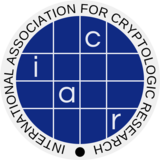
The PKC (Public Key Cryptography) Test-of-Time Award 2021
May 2021 - Dr. Rei Safavi-Naini's paper won the Test of Time Award by the International Association for Cryptologic Research (IACR)

Invited Talk for the Online Charter Series
“Contact Tracing Apps”– Dr. Reardon was an invited speaker for the Online Charter Series at the Centre for Constitutional Studies at the University of Alberta, January 2021.
Selected Past Events

Prof.Rei named NSERC–Telus Industrial Research Chair

Alumni Event - Internet of things
Invited speaker at the "Dig In!" May 2019 UCalgary alumni event- an expert-led, intimate and interactive discussion examining current trends, innovation, technology and more.
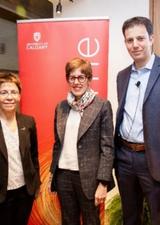
Idea Exchange: Securing the Future of Information
UCalgary Chancellor Deborah Yedlin invited all alumni, donors and friends living in New York and Washington to join the events held in March 2019 on cyber-security presented by Dr. Rei Safavi-Naini,
Invited talk - Nanyang Technological University, Singapore
Invited talk at the Workshop on Modern Trends in Cryptography held by the School of Physical & Mathematical Sciences.
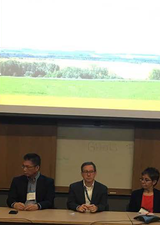
Blockchain- An Introduction
Dr. Safavi- Naini was an invited speaker and panelist at the Blockchain technology demo session for the Government of Alberta (Indigenous Relations and Service Alberta, hosted by Alberta Innovates, May 27, 2019
Past Talks/Seminars (iCIS)
iCIS Group Talk: Matthieu Giraud, June 15, 2018 - 1:00pm to 2:00pm. Venue: ICT 618B
Abstract: Delegating the computation of a polynomial to a server in a verifiable way is challenging. An even more challenging problem is ensuring that this polynomial remains hidden to clients who are able to query such a server. In this talk, I will formally define the notion of Private Polynomial Evaluation (PPE) and give a rigorous security model for indistinguishability against Chosen Function Attack (IND-CFA). I will also present our PPE scheme called PIPE that is IND-CFA secure under the decisional Diffie-Hellman assumption in the random oracle model.
iCIS Seminar: Simpy Parveen, June 1, 2018 - 1:00pm to 2:00pm. Venue: ICT 516
Abstract: The certificates in Public Key Infrastructure helps establish a secure communication channel between communicating en- tities. However, the major concern PKI faces is revocation of certificates which can no longer be trusted and dissemi- nation of this information. The goal of this project is to provide high-level overview of mechanisms that yield revocation information, with the help of Merkle Hash Tree(MHT), while comparing(general evaluation) timeliness, scalability, performance and security with that of traditional schemes. It primarily focuses on the three schemes that use Merkle tree and its variant, namely, Kocher’s CRT(Certificate Revocation Tree), Micali’s Novomodo Scheme and Elwailly et al’s QuasiModo scheme. Also, there is another section for assessment of all the aforementioned schemes based on the data-structure and proof-size complexity.
iCIS Seminar: Shahrokh Valaee, May 14, 2018 - 2:00pm to 3:00pm. Venue: ICT 516
Abstract: Location based applications are receiving much attention recently. Examples include Google maps, Geotagging, Find my friend, virtual reality, and mobile location-based gaming. The need for location estimation will only grow in future when new technologies and services, such as Internet-of-Things, and Smart Cities become prevalent. Gaming industry will also be another strong market for location-based services. The recent interest in playing games such as Treasure hunts and Pokémon GO and their extension into indoor environment suggest that the need for designing and developing effective location estimation technologies will continue to grow in future. In this talk, we will discuss how the new generation of smartphones can provide accurate location estimates. New smartphones are equipped with plurality of sensors such as accelerometer, gyro, barometer, and magnetometer. Using recent advances in signal processing, we have developed precise positioning schemes that can find user’s location in covered areas where the GPS service is not available. Our technology uses RF signals received from WiFi access points or iBeacons, along with the readings from multiple sensors, to locate the user. Our solutions are device-agnostic, which makes them excellent candidates for crowdsourcing. In this talk, we will present some of our localization techniques and will demo our application
iCIS Seminar: Andrew Walenstein, Director of Security R&D, Blackberry's Center for High-Assurance Computing Excellence (CHACE), April 4, 2018 - 3:00pm to 4:00pm. Venue: ICT 516
Abstract: Displayed text is frequently at risk of loss of confidentiality due to shoulder surfing. We have been exploring techniques for combining text with visual distractors in a way that makes the text easily readable at close distances, but distinctly less so at typical shoulder-surfing distances without attracting undue attention. The techniques can be adjusted to the context-of-use to manage tradeoffs between ease of reading and the protection offered. Results obtained with human readers show that the we can generate protected text that is significantly less readable at 120cm yet not significantly less readable for nearer readers at 60cm. In addition to the technique, we also find interesting the questions raised about the interplay between security and usability, most particularly how to measure the security offered by this or similar confidentiality-protection techniques. We explain the measure we have used for evaluation and draw implications for future research in hardware-independent text security.
iCIS Group Talk: Efficient Authorization of Graph Database Queries in an Attribute-Supporting ReBAC Model
Zain Rizvi, February 16, 2018 - 1:00pm to 2:00pm. Venue: ICT 618B
Abstract: Neo4j is a popular graph database that offers two versions; a paid enterprise edition and a free community edition. The enterprise edition offers customizable Role-Based Access Control (RBAC) features through custom developed procedures, while the community edition does not offer any access control support. Being a graph database, Neo4j is a natural application for Relationship-Based Access Control (ReBAC), an access control paradigm where authorization decisions are based on relationships between subjects and resources in the system. We developed AReBAC, an attribute-supporting ReBAC model for Neo4j (applicable to both editions) that provides finer grained access control. AReBAC employs Nano-Cypher, a declarative policy language based on Neo4j's Cypher query language, the result of which allows us to weave database queries with access control policies and evaluate both simultaneously. Evaluating the combined query and policy produces a result that i) matches the search criteria, and ii) the requesting subject has access to. Our experiments show that our evaluation algorithm performs faster than Neo4j's query evaluation engine when evaluating queries that are expressible using Nano-Cypher.
iCIS Group Talk: Dr. Sabyasachi Karati, November 17, 2017 - 1:00pm to 2:00pm. Venue: ICT618B
Abstract: This work considers the problem of fast and secure scalar multiplication using curves of genus one defined over a field of prime order. Previous work by Gaudry and Lubicz in 2009 had suggested the use of the associated Kummer line to speed up scalar multiplication. In this work, we explore this idea in detail. The first task is to obtain an elliptic curve in Legendre form which satisfies necessary security conditions such that the associated Kummer line has small parameters and a base point with small coordinates. In turns out that the ladder step on the Kummer line supports parallelism and can be implemented very efficiently in constant time using the single-instruction multiple-data (SIMD) operations available in modern processors. For the 128-bit security level, this work presents three Kummer lines denoted as K1 := KL2519(81; 20), K2 := KL25519(82; 77) and K3 := KL2663(260; 139) over the three primes $2^{251} -9$, $2^{255}-19$ and 2^{266}-3$ respectively. Implementations of scalar multiplications for all the three Kummer lines using Intel intrinsics have been done and the code is publicly available. Timing results on the recent Skylake and the earlier Haswell processors of Intel indicate that both fixed base and variable base scalar multiplications for K1 and K2 are faster than those achieved by Sandy2x which is a highly optimised SIMD implementation in assembly of the well known Curve25519; for example, on Skylake, variable base scalar multiplication on K1 is faster than Curve25519 by about 25%. On Skylake, both fixed base and variable base scalar multiplication for K3 are faster than Sandy2x; whereas on Haswell, fixed base scalar multiplication for K3 is faster than Sandy2x while variable base scalar multiplication for both K3 and Sandy2x take roughly the same time. In fact, on Skylake, K3 is both faster and also offers about 5 bits of higher security compared to Curve25519. In practical terms, the particular Kummer lines that are introduced in this work are serious candidates for deployment and standardization.
iCIS Seminar: Joel Reardon, October 26, 2017 - 1:00pm to 2:00pm. Venue: ICT 516
Abstract: Mobile phones store a great deal of sensitive information and also get used by a great number of different 'apps'. Permission systems are a security technique to control access to sensitive resources by granting or denying permission based on the application and the user's desires. Android's permission system, however, has suffered from many design failures. In this talk, we give an overview of these systems, and present our own design of a machine-learning-based classifier to improve decision accuracy based on real-world studies of users in practice. Making automated decisions, however, means that the user must be able to review and redress any decision, which is particularly important if it was not what the user desired. To that end, we design and evaluate a permission management dashboard that we evaluated through a 600-person user study.
iCIS Seminar: Idan ShohamCTO-Hitachi ID Systems, Inc. October 20, 2017 - 1:00pm to 2:00pm. Venue: ICT 516
Abstract: The talk will cover:
* An overview of the business drivers and processes that underpin identity and access management in medium to large organizations.
* Mapping business drivers to required capabilities in IAM, credential management and privileged access management (PAM) systems.
* An overview of Hitachi ID Systems, which develops IAM software, based in Calgary.
* Discussion of research topics (to consider and to avoid) in the IAM area.
* Wrap up with a shameless plug for job openings at Hitachi ID
Christina Nita-Rotaru, Northeastern University, October 6, 2017 - 11:00am. Venue: ICT 618B
Abstract: The proliferation of mobile and web applications and their performance requirements have exposed the limitations of current secure transport protocols, particularly during connection establishment. As a result, protocols like QUIC and TLS v1.3 were proposed to address such limitations. In this work we analyze the trade-offs between provable security and performance guarantees in the presence of attackers by focusing on QUIC. We first introduce a security model for analyzing performance-driven protocols like QUIC and prove that QUIC satisfies our definition under reasonable assumptions on the protocols building blocks. However, we find that QUIC does not satisfy the traditional notion of forward secrecy that is provided by some modes of TLS, e.g., TLS-DHE.
iCIS Seminar: Giulia Traverso, August 31, 2017 - 1:00pm to 2:00pm. Venue: ICT 618B
Abstract: Distributed storage allows to outsource a document to the cloud such that multiple users can easily access the file. The protection of the document stored relies on secret sharing, which generates and distributes shares of the document to the storage servers. However, the users have to trust that a certain amount of storage servers behaves honestly and do not lose (retrievability) or reveal (confidentiality) the document. To address this so called social secret sharing schemes were developed that allow to adjust the distribution of shares according to the experience made with the involved storage servers. In this work, we provide a framework called AS$^3$ that allows to build social secret sharing schemes based on dynamic secret sharing. The resulting protocol has more freedom in adjusting the parameters of the shares distribution and therefore leads to more efficient and accurate solutions as well as an optimal storage consumption. Furthermore, we provide measures to detect and to prevent that the document is lost or accidentally revealed to individual storage servers. We also demonstrate how to compute trust values for storage servers, how to initialize trust values for newcomers, and provide a proof of concept implementation.
Privacy Security Trust 2017 (PST 2017)
University of Calgary, Rozsa Centre
Mon. August 28, 2017 (All day) to Wed. August 30, 2017 (All day)
iCIS Group Talk: Sepideh Avizheh, July 14, 2017 - 1:00pm to 2:00pm. Venue: ICT 618B
Abstract: Bitcoin is the first decentralized digital currency which has attracted a great market from its emerging date, 31 October 2008. According to International Business Times, as of February 2015, the number of merchants who accept Bitcoin as a payment method has passed 100,000. This statistic reveals the fact that good understanding of the protocol along with its security evaluation against new attacks is of great importance. Unfortunately, in spite of the improvements applied to Bitcoin protocol, by the Bitcoin community and security experts, it still suffers from some security vulnerabilities.
In this presentation, I will mainly focus on explanation of Bitcoin protocol as well as its components such as the famous backbone public ledger, blockchain. It is interesting to mention that blockchain, nowadays, has found its way not only in new alternative cryptocurrencies, but also in other different areas such as internet of things, health care systems, and pharmaceutical chain management systems, to name but a few. In addition to the protocol description, if time permits, I will introduce two new attacks targeting the Bitcoin protocol; one of them aims at stealing money and the other tries to run money laundry through Bitcoin protocol without being detected. Finally, a modification to Bitcoin protocol is proposed to mitigate these attacks
iCIS Group Talk: Shawn Eastwood, PhD candidate in ECE Department/Biometric Technologies Laboratory, June 22, 2017 - 1:00pm to 2:00pm. Venue: ICT 618B
Abstract: Risk Assessment is the practice of determining the threat posed to a system by using “risk quantities” to evaluate potential unwanted scenarios. In biometric security systems, information is collected from various sources and compiled into risk values using the process of information fusion. Information fusion is the process of combining the observations of various sensors (in our case biometric sensors) into a single conclusion. The process of information fusion varies depending on the limitations of the input data, and the requirements of the fused result. This presentation will cover various approaches to information fusion. Approaches that will be covered will be based on probability theory, credal sets (which are convex sets of probability distributions), probability interval distributions, and Dempster-Shafer models. These approaches are founded in objective requirements. In addition, more heuristic approaches will also be introduced.
iCIS Seminar: Dr. Florian Kerschbaum, June 15, 2017 - 2:00pm. Venue: ICT 618B
Abstract: We present a cryptographic approach to privacy in IoT, using the examples of Smart Grid and Road Toll Collection. All data is encrypted before transmitting to the service provider and all computations are done on encrypted. We ensure multi-lateral security by using zero-knowledge proofs and controlled observation to ensure the integrity of computation for correct billing. This talk will briefly present protocols for billing, aggregation and general computations in the smart grid and billing in road toll collection
iCIS Group Talk: Zain Rizvi, June 2, 2017 - 1:00pm. Venue: ICT 618B
Abstract: Relationship-Based Access Control (ReBAC) bases its authorization decisions on the relationships between the entities in the system, while Attribute-Based Access Control (ABAC) bases its authorization decisions on the attributes of the requestor, the resource, and the environment. The focus of this project is to combine ReBAC and ABAC to form an access control model that supports both relationships and attributes for authorization decision. This combined model uses Neo4j, a graph database, as its backend for storing the protection state. Along with formalizing this model, I will also provide a simple policy language that will allow end users to easily specify access control policies as well as an efficient authorization checking algorithm. The formalization described in this work will be accompanied with supporting tools/libraries so that end users can find the model easily useable.
ARCP: An architecture for the use of cloud computing in pervasive computing environments
iCIS Group Talk: Henrique Pereira, May 12, 2017 - 1:00pm. Venue: ICT 618B
Abstract: Modern world can be characterized by the quick proliferation of mobile devices and by the intense use of computers on our daily lives. Some of the problems found in pervasive computing are not from a technical order, but due to a lack of standards and models that allow devices to interoperate. Pervasive environments are marked by having sudden and frequent changes, making it necessary to think of a way to manage context representation and information. This talk aims to show a solution that could be used to create pervasive computing environments using cloud-based resources and ontologies for context management.
iCIS Group Talk: Carlos Fuentes Carranza, March 29, 2017 - 1:00pm. Venue: ICT 516
Abstract: The Internet of Things (IoT) is the concept of connecting any type of devices to the Internet. This includes cellphones, washing machines, thermostats, wearable devices, industrial machinery, etc. This concept has caught the attention of numerous companies who are trying to come up with their own solutions for the different vertical markets of IoT such as: Home Automation, Automotive, Healthcare and Manufacturing. In this presentation, I will talk about three of the many different types of middleware architectures used to enable devices to communicate to one another, even under very constrained environments.
iCIS Group Talk: Arash Afshar, March 10, 2017 - 1:00pm to 2:00pm. Venue: ICT 618B
Abstract: This talk is meant to be an introductory talk to the field of Secure Two-Party Computation (2PC). Secure two-party computation allows two mutually distrusting parties to run a computation on an arbitrary function such that at the end of the computation nothing about their private input is leaked except for the output of the computation. The seminal work of Yao in 1986 provided the first feasibility proof that such a computation is possible using the so called garbled circuits and given an Oblivious Transfer protocol assuming that the adversary is honest-but-curious (i.e. the adversary follows the steps of the protocol but tries to learn more than he should by looking at the protocol transcript).
In this talk we describe the scope of 2PC and present the Yao's protocol. We also introduce the Real/Ideal world paradigm that is used to prove the security of 2PC protocols. Finally, we introduce some of recent works in this field
iCIS Group Talk: Dr. Sabyasachi Karati, March 3, 2017 - 1:00pm to 2:00pm. Venue: ICT 618B
Abstract: SWIFFT is a collection of compression functions that are highly parallelizable and admit very efficient implementations on modern microprocessors. The main technique underlying these functions is a novel use of the Fast Fourier Transform (FFT) to achieve “diffusion,” together with a linear combination to achieve compression and “confusion.” These functions are set apart from prior proposals to it (having comparable efficiency) by a supporting asymptotic security proof : it can be formally proved that finding a collision in a randomly-chosen function from the family (with noticeable probability) is at least as hard as finding short vectors in cyclic/ideal lattices in the worst case.
We are also going to discuss a One-Time-Signature scheme that takes the advantage of the SWIFFT. The signatures are short and of constant-size, and also computationally efficient. This scheme is post-quantum secure as long as the SVP in ideal lattices is hard in the presence of a quantum computer.
iCIS Group Talk: Dr. Fuchun Lin, February 10, 2017 - 1:00pm to 2:00pm. Venue: ICT 618B
Abstract: Tamper resilient cryptography has recently gained attention,and novel coding solutions have been proposed. One such solution is Tamper Detection (TD) codes that are used to detect tampering with a codeword when the tampering function belongs to a specified family of functions. We consider a tampering function class that consists of functions where the adversary first selects a subset of size n \rho of the codeword components to see (n is the codeword length), and then uses this view to choose a noise vector that will be added (algebraically) to the codeword. We show it is impossible to construct codes that protect against tampering of all functions in this class. By removing the set of bad functions from the class, we obtain a subset of this class for which TD codes exist, and give a construction of TD codes for this subset of the tampering functions. We discuss our results and directions for future work
iCIS Group Talk: Morshedul Islam, December 2, 2016 - 1:00pm to 2:00pm. Venue: ICT 618B
Abstract: Profile-based authentication systems store users' profile data at the verifier and use it to verify their authentication claims. A profile captures user-specific information that could be privacy sensitive and so a profile-based authentication system leaks additional (to what is required for their authentication) information about the user to the verifier. We propose a novel non-cryptographic approach to providing privacy for user profiles against an honest-but-curious verifier. It also allows the correctness of the authentication to remain the same
iCIS Group Talk: Raushan Dilruba, November 18, 2016 - 1:00pm to 2:00pm. Venue: ICT 618B
Abstract: Software Defined Networking (SDN) is one of the key networking technologies with application to data centers and cloud, as well as growing application in networking. SDN uses isolation of data planes and control planes to offer more effective control of networks. Security and reliability of communication between controllers and network switches are essential in SDN architecture. We propose a post-quantum secure and reliable solution to securing the OpenFlow channel between SDN controller and the OpenFlow switch, using Shamir Secret Sharing. Our solution delivers (i) Post-Quantum security, (ii) Reliable Message Delivery, and has (iii) Low communication delay, under the defined system and adversarial model.
iCIS Group Talk: Ahmad Ahmadi, November 4, 2016 - 1:00pm to 2:00pm. Venue: ICT 618B
Abstract: Distance bounding (DB) protocol allow a prover to convince a verifier that they are within a distance bound to the verifier. We consider anonymous distance-bounding protocols that provide security against all known DB attacks, besides providing anonymity of provers against verifier.
Our model provides a natural way of modeling the strongest man-the-middle attack, making security of DB protocols in line with identification protocols. This model is an extension of the recent distance-bounding identification DBID model, that allows provers to remain anonymous from the verifier. We propose a converter, AnonGDB, that takes a specific distance-bounding identification protocol and converts it to an anonymous DB protocol. An important advantage of this protocol is computational efficiency compared to similar protocols, which makes it to be applicable in small devices
iCIS Seminar: Brian LaMacchia, October 12, 2016 - 2:00pm to 3:00pm. Venue: ICT 516
Abstract: In an August 2015 announcement, the Information Assurance Directorate of the US National Security Agency announced plans to begin a transition from the existing “Suite B” cryptography to quantum-resistant algorithms. Since Peter Shor of AT&T Bell Laboratories first published an efficient quantum algorithm for factoring in 1994, we have known that when a general-purpose quantum computer of sufficient size is built then all our commonly-used public-key cryptographic algorithms will be broken. Recent progress in the physics and engineering of quantum computation is changing our assumptions about the feasibility of building a cryptographically-relevant quantum computer, and while there are still technical challenges to address, the best estimates today are that such a machine could become feasible in as little as 10-15 years. Given our experience with past cryptographic algorithm transitions, this time horizon means that we need to start today the process of identifying hard problems that are quantum resistant, developing efficient cryptographic algorithms based on those problems, standardizing these algorithms and deploying them broadly, and deprecating our existing public-key cryptosystems.
iCIS Group Talk: Masoumeh Shafieinejad, September 30, 2016 - 1:00pm to 2:00pm. Venue: ICT 618B
Abstract: One-time signature (OTS) schemes are important cryptographic primitives that can be constructed using one-way functions, and provide post-quantum security unlike many widely used signature schemes which are based on hardness of factorization or discrete logarithm problems. In this this talk I will explain the idea of using Bloom Filters as the one way function in an OTS, in combination with 1-Cover Free Families in order to sign as many messages as possible. I will demonstrate the security and performance evaluation of the scheme and the challenges I face.
iCIS Group Talk: Dr. Hadi Ahmadi, September 16, 2016 - 1:00pm to 2:00pm. Venue: ICT 616
Abstract: Access Management is concerned with authenticating users and determining whether they have permission to access requested resources. Core to any Access Management platform is the design and implementation of access control policies. In this talk, we will discuss about graph databases and their advantages to the Access Management world and illustrate a few interesting application scenarios that show how to solve custom and complicated access control policies taking advantage of this concept, by integrating ForgeRock(TM) Identity Platform and Neo4j(TM) Graph Database.
iCIS Group Talk: Mamunur Akand, September 2, 2016 - 1:00pm to 2:00pm. Venue: ICT 616
Abstract: Location-based services have grown rapidly in recent years. In location-based access control, a user's location information is the basis for granting access to resources and so it is important that location claims are correctly verified. A competing requirement is the users' desire for not revealing their exact location for privacy reasons. In-region location verification systems check if a user is within a region. We propose a privacy enhanced location verification system that uses in-region location verification approach for a given a policy region, and verifies if a location claim is from within the region or not. The novelty of our work is to use distance bounding protocols to construct a pseudo-rectangle (P-rectangle) that is the best cover for the region, and verify the claim with respect to the P-rectangle. We define the error in verification decision, and show that it can be reduced by subdividing the area and using multiple rectangles to cover it. We analyze privacy of the system against an adversary who monitors the radio communication and use it to infer the location of the prover, and provide methods of protecting against this attack. We discuss our results and propose directions for future research.
iCIS Seminar: Dr. Go Ohtake, August 12, 2016 - 2:00pm to 3:00pm. Venue: ICT 618B
Abstract: Integrated broadcast-broadband services allow viewers to simultaneously receive broadcast content over the airwaves and additional information related to the content over the Internet. These services can be enriched and personalized by using viewers' personal information such as viewing history. This, however, requires viewers to share their viewing history with service providers, hence raising privacy concerns. Using attribute-based encryption (ABE) one can empower viewers to share their viewing history with service providers who satisfy certain criteria (e.g. have well-established reputation). ABE systems require computation that may not be affordable by less resourceful clients. To reduce this computation, in this paper we propose an outsourcing scheme for ABE encryption. Our work is the first to consider security against a malicious cloud server that does not follow the protocol and may collude with other entities in the system. We motivate and introduce the required security notions that guarantee correctness of the outsourced operation and privacy of the viewers' personal information, and prove the security of our scheme in the proposed model. We implement our scheme and show that the encryption cost of a user terminal can be dramatically reduced compared to that by using the conventional ABE system.
iCIS Group Talk: Ebrahim Tarmeshloo, August 10, 2016 - 3:30pm to 4:30pm. Venue: ICT 618B
Abstract: With the proliferation of the Internet and GPS enabled smartphones, Geo-Social Computing Systems (GSCS) have seen widespread adoption. Facebook, Twitter, Waze, Geofeedia, WeLink are among the many GSCS with various members and services. These systems rapidly gained traction for two types of target users, a) GSCS members (data contributors), and b) GSCS data consumers.
For GSCS data contributors, these systems empower mobile members with knowledge of their vicinity, and thus significantly promote social interactions in contexts including transportation, marketing, health, and the general cultivation of personal and professional relationships.
The benefits of using GSCS are not limited to their members. The data that has been collected has high value in the analysis of different use cases within the context of urban planning, public safety, and social behaviors. One of the most well known consumers of GSCS data is Social Media Monitoring Systems (SMMS) that actively collect information from different social media channels. SMMS analyze volume, trend, and opinion about a topic or brand in different geographical area. WeLink, Snaptrends, and BlueJay are a few instances of SMMS.
Although GSCS deliver valuable services, they also generate a host of privacy challenges. Protecting members' identity and their location information is a notable challenge in GSCS. Close examination of nine real life GSCS applications enabled me to identify four major challenges that can lead to insufficient privacy protection for members of GSCS.
My seminar is structured based on the four identified privacy challenges that are categorized into two core perspectives on privacy issues in GSCS. Part I focuses on the privacy issues inside GSCS either as a single system or a federation of systems. The perspective for Part I is to look at privacy issues when a member wants to access another member's data. Part II looks at the privacy problems when geo-social networking systems make their members' data publicly available. The perspective for this part is to look at privacy issues when data recipient can access all members’ data yet in a sanitized format. I will discuss details of my contributions and findings as well as future directions within these two main perspectives
iCIS Group Seminar: Neal Isaac, June 24, 2016 - 2:00pm to 3:00pm. Venue: ICT 616
Abstract: In today’s rapidly expanding security marketplace cyber risk, cyber crime, cyber threats, cyber intelligence are all making cyber headlines. All of these have one common theme: Cyber.
Join our guest Neal Isaac, the “Cyber Guy”, for an open discussion on what lessons can be learned from recent incidents of cybercrime, such as the ransomware that we recently experienced, what he is seeing across various sources of information and what opportunities he feels may exist in the future.
iCIS Group Seminar: Dr. Go Ohtake, November 24, 2015 - 1:00pm to 2:00pm. Venue: ICT 618B
Abstract: A number of integrated broadcast-broadband services have been launched and a viewer can enjoy the broadcast content via the airwaves and also receive additional information related to the content via the Internet. These services, however, can be enriched by using the viewers' personal information such as a viewing history. To this end, it is required that the viewer can securely share their viewing history with the broadcaster and the service providers. We proposed a privacy preserving system for integrated broadcast-broadband services that uses an attribute-based encryption (ABE) scheme. However, an ABE scheme has usually a heavy cost for user terminal including television, smartphone, and tablet that might have a low-performance CPU. Recently, several outsourcing schemes of ABE encryption have been proposed to reduce the encryption cost for user terminal. In these schemes, a cloud server performs a large part of ABE encryption algorithm. However, it is assumed that a cloud server is honest or honest-but-curious. In this talk, we propose an outsourcing scheme of ABE encryption which is secure against a malicious cloud server. We define three security notions and prove that our scheme satisfies all of them in the random oracle model.
iCIS Group Seminar: Dr. Viliam Lisy, September 21, 2015 - 1:00pm to 2:00pm. Venue: ICT 618
Abstract: Game Theory provides theoretic and algorithmic framework for analyzing optimal behaviour in competitive situations. After its initial development in economics and success in electronic commerce, it has been increasingly often used for modelling real world physical and network security problems.
In my talk, I will introduce the main modelling tools, advantages and limitations of using game theory for real world applications. I will explain the most basic formal models as well as several specific applications from physical and network security. I will demonstrate the most important concepts on a game theoretic model of selecting detection thresholds in a network intrusion detection system and show that strategic randomization can ensure higher expected detection rates than any static threshold setting. I will focus on computational/algorithmic game theory, which allows analyzing models hard to study analytically, because of their size or dependence on real world data that cannot be expressed analytically
iCIS Group Seminar: Dr. Borzoo Bonakdarpour, August 27, 2015 - 11:00am to 12:00pm. Venue: ICT 616
Abstract: Cybersecurity is an area of information technology where dependability plays a crucial role. This is because even a short transient violation of security policies may result in leaking private or highly sensitive information, compromise safety, or lead to the interruption of vital public or social services. This talk will go over a general runtime monitoring technique for a rich class of security polices (e.g., information flow) that cannot be expressed by traditional trace-based specification languages. To this end, we employ Clarkson and Schneider's theory of hyperproperties. We first define the notion of monitorability and identify monitorable policies. Then, I will describe the complexity of runtime monitoring of such policies and introduce related algorithms.
Using Secure Multiparty Computation to Secure Outsourcing of Computation: What Theoreticians Missed
iCIS Group Seminar: Prof. Yvo Desmedt, August 13, 2015 - 12:00pm to 1:00pm. Venue: ICT 618B
Abstract: Amazon, Facebook, Twitter, and other companies have invested heavily in social networks, in cloud computing, and in cloud storage. They depict a great new world in which local in person contacts/friends are being replaced by global virtual ones, local storage of data is being replaced by cloud storage, and so forth. The US government and presidents/provosts of numerous universities have been lured into switching to the use of the cloud.
First, one can wonder how secure these cloud servers are. Second, even though a lot of fundamental/theoretical research on cloud security is extremely exiting, there is no motivation for social networks, cloud storage and cloud computing corporations to implement and incorporate the results. Moreover, in countries such as Japan and the USA, lobbyists dominate the government and Europe's regulation (such as the need to authorise the use of cookies) is ineffective.
We start this lecture by explaining the rise of cloud storage, cloud computing and social networks as a consequence of a failure in the design of adequate OS (operating systems). We survey some of the solutions proposed to address security problems. Some of these solutions are user-developed ones, which do not require the cooperation of the companies, and might therefore have a better chance of success.
Theoreticians have been pushing the use of secure multiparty computation (MPC) to address the problem of outsourcing computation in a secure way. A major part of this presentation is focused on analyzing whether MPC is the correct technique for this problem. We identify several problems that have been overlooked in the context of the secure outsourcing of computation.
iCIS Group Seminar: Dr. Mahdi Cheraghchi, August 6, 2015 - 1:00pm to 2:00pm. Venue: ICT 616
Abstract: The Hadamard transform, also known as the Fourier transform over the hypercube, is an orthogonal transformation extensively used in signal processing, learning theory, coding theory, and Boolean function analysis. Using the standard FFT algorithm, the N-dimensional Hadamard transform can be computed deterministically and exactly in time O(N log N). However, when one wishes to only approximate the most significant coefficients of the transformation, it is possible to obtain faster algorithms that work in sublinear time in the signal's dimension. We design an algorithm for computing a k-sparse approximation of the Hadamard transform of an N-dimensional vector x in time O(k^1.01 polylog N). Our algorithm is fully deterministic and only uses non-adaptive queries to x (i.e., all queries are determined and performed in parallel when the algorithm starts). Along the way, we also obtain a nearly optimal and explicit compressed sensing scheme equipped with a deterministic sublinear-time recovery algorithm.
[Based on joint work with Piotr Indyk; arXiv manuscript 1504.07648]
iCIS Group Seminar: Dr. Mahdi Cheraghchi, August 4, 2015 - 1:00pm to 2:00pm. Venue: ICT 618B
Abstract: The general area of non-malleable cryptography aims for providing the maximum degree of security in a cryptosystem; that is, securing against a tampering adversary who is able to observe an encrypted message and wishes to create the encryption of a correlated message. Non-malleable codes, introduced by Dziembowski, Pietrzak and Wichs (ICS 2010) are regarded as a central combinatorial tool in this area. A direct application of a non-malleable coding scheme makes it possible to secure a cryptosystem against tampering of memory components that store sensitive information. While this has been the original application leading to the development of non-malleable codes, the abstraction is so natural that has led to numerous other applications within non-malleable cryptography. As a coding-theoretic object extending the notion of error-detecting codes, non-malleable codes are also of interest to the information and coding theory communities.
In this talk, I discuss the background on non-malleable cryptography and introduce the notion of non-malleable codes. The talks follows by a discussion of the following:
1. How non-malleable codes can be applied to provide security against tampering of the storage;
2. Existence of non-malleable codes for any given family of tampering adversaries, and matching upper and lower bounds on their redundancy;
3. Constructions of non-malleable codes; including a general and efficient randomized construction as well as an explicit optimal constructions for the so-called “bit-tampering” adversaries;
4. More recent applications of non-malleable codes in cryptography, such as public-key encryption and string-commitment schemes secure against chosen ciphertext attacks;
5. Remaining open problems in the area.
Based on joint work with Venkatesan Guruswami and articles arXiv:1309.0458 (ITCS 2014) and arXiv:1309.1151 (TCC 2014).
iCIS Group Seminar: Liam Keliher, May 20, 2015 - 1:00pm to 2:00pm. Venue: ICT 618
Abstract: BSPN (byte-oriented SPN) is a general block cipher structure presented at SAC'96 by Youssef et al. It is a more efficient version of the bit-oriented SPN structure published earlier in 1996 by Heys and Tavares. BSPN is a flexible SPN design in which only the linear transformation layer is exactly specified, while s-boxes, key-scheduling details, and number of rounds are intentionally left unspecified. Because it is designed to be involutional (self-inverting), BSPN has influenced other involutional ciphers such as Khazad and CURUPIRA. And because it can be implemented very efficiently in hardware, several researchers have recommended the 64-bit version of BSPN for use as a lightweight cipher. Youssef et al. perform preliminary analysis on BSPN, and claim it is resistant to differential and linear cryptanalysis for typical block sizes and numbers of rounds. However, we show that even if BSPN is instantiated with strong AES-like s-boxes, there exist high probability differentials and linear hulls that allow BSPN to be broken using differential and linear cryptanalysis. In particular, up to 9 rounds of BSPN with a 64-bit block size can be attacked, and up to 18 rounds with a 128-bit block size can be attacked.
iCIS Group Seminar: Douglas Stinson, May 11, 2015 - 4:00pm to 5:00pm. Venue: ICT 616
Abstract: We study a method for key predistribution in a network of n users where pairwise keys are computed by hashing users' IDs along with secret information that has been (pre)distributed to the network users by a trusted entity. A communication graph G can be specified to indicate which pairs of users should be able to compute keys. We determine necessary and sufficient conditions for schemes of this type to be secure. We also consider the problem of minimizing the storage requirements of such a scheme; we are interested in the total storage as well as the maximum storage required by any user. Minimizing the total storage is NP-hard, whereas minimizing the maximum storage required by a user can be computed in polynomial time.
iCIS Group Seminar: Krzysztof Wróbel, February 26, 2015 - 11:00am to 12:00pm. Venue: ICT 618B
Abstract: The most popular biometric identification methods include: signature recognition, iris recognition, fingerprint recognition and profiling. There are also other methods, e.g. cheiloscopy, which are becoming more popular. A single lip print contains, on an average, 1145 individual features forming a unique pattern different for each person. There is no doubt that such a huge potential of lip prints can be used for personal identification.
In this talk the methods of lip print recognition on the basis of Standard and Generalized Hough Transform will be introduced. The advantage of these methods is the possibility of use in biometric systems and forensic science.
iCIS Group Seminar: Rafal Doroz, February 26, 2015 - 11:00am to 12:00pm. Venue: ICT 618B
Abstract: Many methods of determining the similarity between signatures require that the signatures being compared have the same length. This requirement is not always fulfilled. This causes a necessity to use a method of equalizing the length of signatures. Lengths of sequences can be equalized using many methods, such as DTW or scaling methods. A disadvantage of these methods is the need to interfere with the analysed data, which in turn may lead to distortion of the signatures being compared.
In this talk a on-line signature identification system using Windows Technique will be describe. The identified signature is compared with signatures stored in database and decision is made by three different voting schemes: Borda’s, Copeland’s and Coomb’s method.
iCIS Group Seminar: Aaron Sheldon, January 22, 2015 - 11:00am to 12:00pm. Venue: ICT 618B
Abstract: Recently the ministry of Alberta Health and the health authority of Alberta Health Services have been discussing the technical privacy implications of the disclosure of information. This discussion is motivated by the growth in both the release of summary, aggregate, and statistical data, and the requests for confidential data for research purposes. As part of this discussion a series of simple toy examples were developed, and summary notes of the foundational topics in the computer science field of information privacy were written. This presentation will cover these notes and examples, and should be accessible to an audience with undergraduate training in the sciences. To keep the presentation within a reasonable length of time an exhaustive list of references to the underlying literature will not be included, however the relevant material can be readily found using any of the currently popular search engines.
iCIS Group Seminar: Dr. Michael Reiter, November 21, 2014 - 9:30am to 10:30am. Venue: ICT 618B
Abstract: In a typical large enterprise or Internet service provider setting, the configurations of potentially hundreds of distributed network devices collectively enforce security on the network. In contrast to the isolated operation and manual configuration of these devices today, we are exploring frameworks to enable these devices to work in a coordinated fashion and to be configured collectively, using only device-specific capabilities and high-level operator objectives as inputs. We will discuss our progress on accomplishing this vision for intrusion-detection monitoring, intrusion-prevention policy enforcement, and network flow monitoring, for example. Topics covered will range from formulation of these applications as optimization problems through development and performance of working implementations
iCIS Group Seminar: Dr. Aysajan Abidin, November 19, 2014 - 11:00am to 12:00pm. Venue: ICT 618B
Abstract: Biometrics are increasingly becoming popular as a promising alternative for user authentication and identification. At the same time, however, privacy concerns associated with the widespread use of biometrics are also increasing, since biometrics cannot be revoked if compromised, and more serious, biometrics reveals sensitive private information. Moreover, biometrics can be used to profile and track users. Hence, privacy-preserving biometric authentication is of utmost importance.
The overall focus of the talk is on the security of existing privacy-preserving biometric authentication protocols against malicious internal adversaries. I will first briefly talk about privacy issues with biometrics and common cryptographic techniques employed to build privacy-preserving biometric authentication. Then, I will present two protocols that are built using the Goldwasser-Micali cryptosystem and ring-LWE based somewhat homomorphic encryption, respectively. After motivating why the security against malicious internal adversaries is important in practice, I will describe some attacks on these protocols. Finally, possible countermeasures to mitigate the attacks and to eventually achieve provable security are discussed.
iCIS Group Seminar: Dr. Yvo Desmedt, University of Texas at Dallas, August 14, 2014 - 2:00pm to 3:00pm. Venue: ICT 616
Abstract: On 26th of October 2012, at the closed workshop on ``Online Security & Civil Rights: a Fine Ethical Balance,'' Hertfordshire, UK, the author put forward the idea that intelligence agencies should work for the People and not for the government. That means that the intelligence agencies should spy on these working in the government and these working for lobbyists. The recipient of this information should be the public at large. The foundation of this idea comes from the Magna Carta and the US Civil Rights Bill that regard ``We the People'' as the trust worthy party and the government as potentially corrupt.
After the Snowden leaks, it has become evident that a discussion is needed on how to reorganize the huge intelligence agencies so that they fit a Western thinking and to avoid they are evolving into a clone of what the KGB and the Stasi used to be.
An updated version of this this lecture was presented a second time at the Security Protocols Workshop, Cambridge on March 20, 2014
iCIS Group Seminar: Dr. Shaoquan Jiang, August 7, 2014 - 2:00pm to 3:00pm. Venue: ICT 616
Abstract: Commitment is a cryptographic protocol, in which a sender can promise a message to a receiver without disclosing it (hiding property) but later he can only unambiguously open it (binding property). A traditional commitment assumes that the channel between the sender and the receiver is noiseless. In this talk, we consider the commitment problem over a discrete memoryless channel (DMC) and assume both the sender and the receiver are deterministic. We call it a DET-DMC commitment. We are concerned with the hiding error $\delta_h$ and binding error $\delta_b$ and will discuss them regarding the security definition. We give a framework of a DET-DMC commitment and characterize the condition under which $\delta_h$ is nearly zero and $\delta_h$ is exponentially small. We also present some impossibility results for a DET-DMC commitment.
iCIS Group Seminar: Prof. Keith Martin, August 6, 2014 - 11:00am to 12:00pm. Venue: ICT 618B
Abstract: There are Cyber Security summits, Cyber Security strategies, Cyber Security agendas, an Office of Cyber Security, Cyber Security degrees, Cyber Security Centres of Excellence and even a Cyber Security skills crisis. But what is everybody getting so agitated about? Is Cyber Security anything new, or just something that we (the “profession”) all knew about before everyone else caught up with it? In this talk we’ll examine Cyber Security from a number of different perspectives and consider some of the things that might have changed, as well as identify some of the challenges for the future.
iCIS Group Seminar: Dr. Matt Robshaw, March 21, 2014 - 11:00am to 12:00pm. Venue: ICT 616
Abstract: In this presentation we will take a technical look at the deployment of cryptographic solutions on RFID tags.
iCIS Group Seminar: Ed Dawson, Queensland University of Technology, September 3, 2013 - 2:00pm to 3:00pm. Venue: ICT516
Abstract: In this presentation I will present an overview of my main contributions to cryptology over last 25 years. Areas of presentation include automated cryptanalysis of encryption algorithms using ciphertext alone, design of statistical package to analyse encryption algorithms, using discrete optimisation techniques to find highly nonlinear boolean functions, design and analysis of stream ciphers, efficient implementation in software of elliptic curve cryptography and compliant cryptographic protocols including electronic cash, electronic voting and electronic auctions.
iCIS Group Seminar: Yvo Desmedt, University of Texas at Dallas, August 9, 2013 - 11:00am to 12:00pm. Venue: ICT 616
Abstract: Perfectly secure message transmission (PSMT) schemes have been studied in the field of cryptography for nearly 20 years and have found applications in other fields of research beyond cryptography.
We introduce a new aspect to PSMT. We consider the case when the hardware/software used by the receiver might be corrupted by the adversary. To address this, we replace the receiver by a human (the dual of this is when the sender is a human).
In this lecture we give a brief survey of Perfectly Secure Message Transmission and then propose two different constructions for such protocols in which the receiver is a human with limited computational power. We also survey experiments that were carried out with human participants to evaluate what humans can compute.
Part of this work was presented at SCN 2012.
iCIS Group Seminar: Yvo Desmedt, University of Texas at Dallas, August 7, 2013 - 11:00am to 12:00pm. Venue: ICT 616
Abstract: Functional encryption is now receiving a lot of attention. However, the topic of functional encryption was preceded by functional secret sharing (SIAM Journal on Discrete Mathematics, 2000).
In this lecture, we explain some of the motivations behind functional secret sharing. We note that in functional secret sharing, we have, as in normal secret sharing, a dealer. However, after the participants received shares from the dealer, a function f will be chosen and the participants will be asked to evaluate f(secret), without any help of the dealer.
Two approaches are surveyed. The first one is non-interactive in the sense that the participants need to broadcast some partial evaluation of f(secret). Since broadcast is used, these partial evaluations should not facilitate a non-authorized set to compute f'(secret), except if f'(secret) follows logically from f(secret). The second approach is interactive in which stricter privacy requirements can be enforced. Most of our solutions are reusable.
We conclude with giving open problems.
iCIS Group Seminar: Frederique Elise Oggier, Nanyang Technological University, June 10, 2013 - 10:00am to 11:00am. Venue: ICT 618B
Abstract: Consider a communication channel, where a transmitter, Alice, sends some information to a receiver Bob, in the presence of an eavesdropper Eve. Wiretap codes are coding strategies that provide reliability between Alice and Bob, but also confidentiality. In this talk, we will survey our recent line of work, by showing how an error probability analysis can provide explicit wiretap code design criteria for Gaussian, fading, and MIMO channels. Progresses on corresponding code constructions will be presented as well
iCIS Group Seminar: Jason Crampton, Royal Holloway University of London, May 9, 2013 - 2:00pm to 3:00pm. Venue: ICT 618B
Abstract: A workflow specification defines a set of steps and the order in which those steps must be executed. Security requirements may impose constraints on which groups of users are permitted to perform subsets of those steps. A workflow specification is said to be satisfiable if there exists an assignment of users to workflow steps that satisfies all the constraints. An algorithm for determining whether such an assignment exists is important, both as a static analysis tool for workflow specifications, and for the construction of run-time reference monitors for workflow management systems. Finding such an assignment is a hard problem in general, but recent work using the theory of parameterized complexity suggests that efficient algorithms exist under reasonable assumptions about workflow specifications. We improve the complexity bounds for the workflow satisfiability problem. We also generalize and extend the types of constraints that may be defined in a workflow specification and prove that the satisfiability problem remains fixed-parameter tractable for such constraints.
iCIS Group Seminar: Susan Landau, April 5, 2013 - 11:00am to 12:00pm. Venue: ICT 616
Abstract: As a result of increasing spam, DDoS attacks, cybercrime, and data exfiltration from corporate and government sites, there have been multiple calls for an Internet architecture that enables better network attribution at the packet layer. The intent is for a mechanism that links a packet to some packet level personally identifiable information. But cyberattacks and cyberexploitations are more different than they are the same. One result of these distinctions is that packet-level attribution is neither as useful nor as necessary as it would appear. In this talk, I analyze the different types of Internet-based attacks, and observe the role that currently available alternatives to attribution already play in deterrence and prosecution. I focus on the particular character of multi-stage network attacks, in which machine A penetrates and ``takes over'' machine B, which then does the same to machine C, etc. and consider how these types of attacks might be traced, and observe that any technical contribution can only be contemplated in the larger regulatory context of various legal jurisdictions.
This represents joint work with David Clark of MIT.
iCIS Group Seminar: Giovanni Vigna, University of California in Santa Barbara, February 8, 2013 - 11:00am to 12:00pm. Venue: ICT 616
Abstract: In recent years, attacks targeting web browsers and their plugins have become a prevalent threat. Attackers deploy web pages that contain exploit code, typically written in HTML and JavaScript, and use them to compromise unsuspecting victims. The malicious code involved in web-based attacks changes over time. Attackers routinely tweak it to create new and more effective variants (for example, by incorporating exploits targeting newly-discovered vulnerabilities) or to evade commonly-used defensive tools. Such tweaks (that is, code evolution) have not yet been studied in depth.
In this presentation we present our initial efforts in tracking the evolution of malicious scripts. Our approach uses efficient techniques to identify similarities between a large number of JavaScript programs (despite their use of obfuscation techniques, such as packing, polymorphism, and dynamic code generation), and to automatically interpret their differences.
Using large-scale experiments, we show that our approach is effective at detecting evasion attempts in JavaScript and identifying the code generated by exploit toolkits.
iCIS Group Seminar: Marten van Dijk, January 18, 2013 - 3:00pm to 4:00pm. Venue: ICT 516
Abstract: One of the key issues in cloud computing is \emph{how to keep private data private}. From financial information to medical records, sensitive data is stored and computed upon in the cloud. Computation requires the data to be exposed to the cloud servers, which may be attacked by malicious applications, hypervisors, operating systems, or by insiders. Encrypted computation has the potential to solve this data privacy problem: e.g., Fully Homomorphic Encryption (FHE) has been coined the Holy Grail of cryptography since it allows an untrusted server to perform computation directly on an encrypted ciphertext without having access to the decryption key. As opposed to current secure hardware solutions (e.g., Intel+TXT, XOM or Aegis), FHE does not require the user to trust any component on the server side -- even the application program can be untrusted.
To investigate FHE's promise, which is prohibitively slow in current implementations, we will explore techniques to run general purpose programs given an efficient FHE scheme. It turns out that, for encrypted execution of general programs, even efficient FHE schemes will suffer a large performance loss compared to plain computation: ambiguity in program control flow and data structures leads to large overheads for certain programs, in addition to the crypto overheads already imposed by FHE.
Motivated by large FHE overheads, the second part of the talk describes how to solve the problem of placing trust in programs by designing a tamper-resistant single-chip processor called Ascend (Architecture for Secure Computation on ENcrypted Data), that can run untrusted batch programs, unlike Aegis and related processors that assume trusted programs. Ascend performs program obfuscation in hardware: given an untrusted program and private user data running within the Ascend chip, the chip's external input/output and power pins give off a signal that is independent of the private user data. To avoid privacy leakage over the I/O pins and power pins, Ascend uses Oblivious RAM to manage its external RAM, assumes DPA resistant logic and implements new insights such as accessing all internal circuits at distinct intervals.
Surprisingly, Ascend incurs only 6.1x performance overhead relative to insecure computation, which is orders of magnitude better than what FHE can achieve. The trusted computing base is only the Ascend chip: no software (the user application, server operating system, etc) or anything outside the Ascend processor (external RAM or communication channels) is trusted.
This is joint work with Christopher Fletcher, Srini Devadas, Ling Ren and Xiangyao Yu.
The low-call diet: Authenticated Encryption for call counting HSM users... (plus some new work on EMV)
iCIS Group Seminar: Gaven Watson, January 15, 2013 - 11:00am to 12:00pm. Venue: ICT 516
Abstract: In this talk I shall present a new mode of operation for obtaining authenticated encryption suited for use in environments, e.g. banking and government, where cryptographic services are only available via a Hardware Security Module (HSM) which protects the keys but offers a limited API. The practical problem is that despite the existence of better modes of operation, modern HSMs still provide nothing but a basic (unauthenticated) CBC mode of encryption, and since they mediate all access to the key, solutions must work around this. Our mode of operation makes only a single call to the HSM, yet provides a secure authenticated encryption scheme. This is joint work with Mike Bond, George French and Nigel Smart and is accepted to appear at CT-RSA 2013.
In the second part of the talk I will give a brief overview of ongoing joint work with Christina Brzuska, Nigel Smart and Bogdan Warinschi. EMV, also known as Chip-and-PIN, is the global standard for authenticating credit and debit card transactions. It has been deployed in Europe since 2005 and has become widely used in Canada in recent years. We perform the first formal security analysis of a proposed update to the key agreement protocol of EMV.
iCIS Group Seminar: Paul Van Oorschot, January 9, 2013 - 11:00am to 12:00pm. Venue: ICT 618B
Abstract: A great number of user authentication technologies have been proposed as password replacements over the past 20 years. The claimed superiority of each is apparently, however, contradicted by a small real-world detail: text passwords continue to dominate, and quite dramatically at that. What explains this disconnect between researchers' claims and the real world? The answer is many-fold, including problem definition and evaluation criteria. In fact, only a small subset of evaluation criteria relevant to the real world are considered in most research papers, and the security research community lacks consensus, and consistency, on which should be used. Our exploration considers numerous proposals from a broad spectrum of authentication schemes, and suggests a framework and methodology for comparative evaluation. We also consider a research agenda motivated by these considerations.








